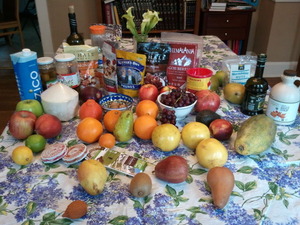The purpose of this email is to brainwash your family and friends into believing we live a wonderful world (65 million views!). Please print and share.
 What do you see in this picture? Seaweed?
What do you see in this picture? Seaweed?
If there were a prize for the world’s best camouflage, it would surely go to the sea dragon, a fish in the waters off southern Australia.
Australians call them "leafies". Those leafy things all over its body seem to have no purpose other than to make it look a like a floating piece of seaweed.
It's good enough a disguise to fool bigger fish. These guys rarely rarely get eaten.
To be extra safe, some also change their color, like a chameleon!
But they can’t fool humans! Divers can spot them and were collecting them to near extinction before the Australian government banned all seadragon collecting.
But humanity has created two new ways to threaten them: pollution and habitat destruction.
 What do you see in this picture? Seaweed?
What do you see in this picture? Seaweed?If there were a prize for the world’s best camouflage, it would surely go to the sea dragon, a fish in the waters off southern Australia.
Australians call them "leafies". Those leafy things all over its body seem to have no purpose other than to make it look a like a floating piece of seaweed.
It's good enough a disguise to fool bigger fish. These guys rarely rarely get eaten.
To be extra safe, some also change their color, like a chameleon!
But they can’t fool humans! Divers can spot them and were collecting them to near extinction before the Australian government banned all seadragon collecting.
But humanity has created two new ways to threaten them: pollution and habitat destruction.
The babies are particularly fragile. Like their sea horse cousins, the daddy seadragon cares for the babies. The mommy uses a special tube to place 150-250 eggs into special pits on his tail. Each egg gets its own pit. The daddy carries them around for a month or so until they hatch. They let him know they’re ready to be born by turning purple or orange. He then shakes his tail and rubs it against rocks to help them hatch.
Question for your table — We know why sea dragons wear camouflage; but why do people wear masks? Do they want to blend in or do they want to be noticed?
Shabbat Shalom
and Happy Purim....
PS: Speaking of the Purim, the best Purim and Pesach ideas have been gathered at bestjewishkidsbooks.com.
PPPS: Today's email is excerpted and adapted from our Amazing Nature program.
|
|
 This week: a question, followed by a story, followed by a question, followed by a really good piece of wisdom.
This week: a question, followed by a story, followed by a question, followed by a really good piece of wisdom.
 The emails are still coming in in reply to my
The emails are still coming in in reply to my 

 Several readers replied to my fantasy
Several readers replied to my fantasy